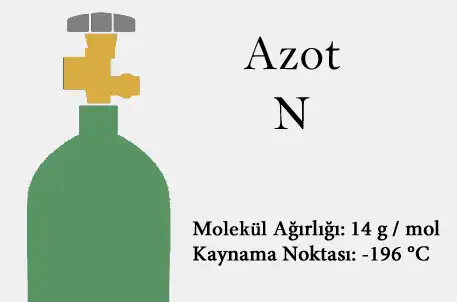Nitrogen gas (chemical symbol N₂) is the most abundant gas in the atmosphere, making up about 78% of the atmosphere. Nitrogen has a diatomic molecular structure and is a very stable gas. It is colorless, odorless, and tasteless. It is usually found free in nature and is very resistant to chemical reaction.
Properties of Nitrogen Gas:
- Chemical Stability:
Nitrogen gas is quite stable at atmospheric pressure and temperature. The triple bond between two nitrogen atoms makes this gas unreactive. It can react under high temperature and pressure or with the help of catalysts.
nitrogen atoms makes this gas unreactive. It can react under high temperature and pressure or with the help of catalysts.
- Colorless, Odorless and Tasteless:
Pure nitrogen cannot be perceived by the human senses; it is a colorless, odorless and tasteless gas.
- Light and Neutral:
One of the most common gases in the air, nitrogen is slightly lighter than air and is known for its inert properties, meaning it is not prone to most chemical reactions.
Areas of Use of Nitrogen Gas:
- Industry and Production:
Protective Atmosphere: Nitrogen gas is used to create a protective atmosphere in environments where reactions with oxygen are undesirable. For example, nitrogen is used to prevent oxidation in electronics production, chemical processing, and metallurgical processes.
Steel Production: Nitrogen atmosphere is used to prevent unwanted reactions with oxygen in the atmosphere during high-quality steel production.
- Food Industry:
It is widely used in packaging foods and extending shelf life. Nitrogen gas is filled into food packages with a process called Modified Atmosphere Packaging (MAP). This prevents food from oxidizing and spoiling.
- Medicine and Health:
Nitrogen is widely used in cryogenic applications in liquid form. Liquid nitrogen is used to freeze human tissues, sperm, eggs, and other biological samples. It is also used in laser and cryotherapy applications.
- Aerospace Industry: Nitrogen is used to inflate aircraft tires. This is because nitrogen causes less pressure change in tires than oxygen, extending the life of tires.
- Chemical and Petrochemical Industry: Ammonia Production: Nitrogen gas is combined with hydrogen in the Haber-Bosch process to produce ammonia (NH₃). Ammonia plays a critical role in fertilizer production and the synthesis of various chemicals.
- Petrochemical Industry:
It is used in oil refineries to inert storage tanks, preventing the formation of explosive gas mixtures.
- Laser and Electronics Production:
Nitrogen is used as a gas in some industrial lasers. In addition, during the production of electronic circuits, nitrogen-filled environments are used to prevent corrosion caused by oxygen.
- Tire Inflation:
Nitrogen is also preferred in the inflation of automobile and aircraft tires. Since nitrogen contains less oxygen in the tires, it reduces the oxidation effect and allows the tires to last longer.
Advantages of Nitrogen Gas:
- Preventing Oxygen Reactivity: Since nitrogen is an inert (non-reactive) gas, it is used in environments where it is undesirable to react with oxygen. This prevents oxidation and deterioration of materials.
- Shielding Gas: Nitrogen is widely used to protect products in many sectors such as electronics manufacturing, metalworking and food packaging.
- Low Cost: Nitrogen is relatively easy and economical to obtain due to its abundance in the atmosphere.
Safety and Precautions:
- Risk of Asphyxiation: Since nitrogen gas is inert, it can displace oxygen in closed environments and create a risk of asphyxiation. Therefore, it is important that areas where nitrogen is used are well ventilated.
- Risk of Freezing of Liquid Nitrogen: Liquid nitrogen has temperatures as low as -196°C. Therefore, it can cause frostbite and frostbite in case of skin contact. It is important to work with protective clothing and gloves.
Nitrogen gas is a versatile gas that is safely used in many industries due to its chemical stability and inertness. It is an indispensable aid in many sectors, especially in chemistry, food, medicine and electronics.
 English
English
 Türkçe
Türkçe


